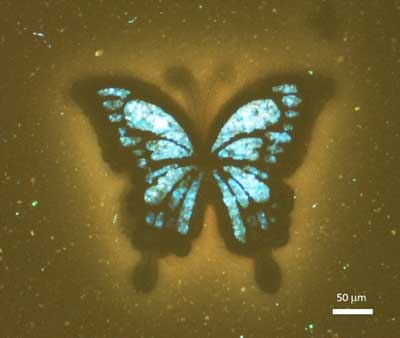| Apr 18, 2018 | |
Recovered carbon black for multicolour fluorescence displays(Nanowerk News) National University of Singapore (NUS) physicists have discovered that recovered carbon black powder can be transformed by laser treatment to give a wide range of colours for potential display applications (Nano Research, "Polychromic carbon black: Laser galvanized multicolour fluorescence display"). |
|
| Recovered carbon black powder is a common pigment produced from scrap rubber tyres. There is a growing demand to use it as an environmentally friendly and sustainable material as a reinforcing filler in tyres and many other applications. | |
 |
|
| Figure shows a multicolour butterfly design which is made by patterning recovered carbon black in ambient and helium environments. (Image: NUS) | |
| A research team led by Prof SOW Chorng Haur from the Department of Physics, NUS has discovered that by applying focused laser treatment to recovered carbon black powder through a photo-thermal process, it can be made to display a wide range of colours. | |
| Recovered carbon black powder often contains different types of metal impurities, a flaw that many deem undesirable. However, when heated in air or in a helium environment using a focused laser beam, the carbon atoms get infused into the metal contaminates. | |
| This process results in the creation of additional energy states in the hybrid materials system and thus allows electrons in the material to hop to different electronic states and emit different colours. At the same time, the heated material changes in its physical form due to heat-induced melting and resolidification of the agglomerated powder, resulting in the formation of periodic arrangements of carbon nanoparticles. The visible colours are also partly due to light scattering from these periodic arrangements. | |
| The researchers also found that they are able to turn off, or dim, the fluorescence coming from the sample by applying an external electric potential. This, coupled with the ability to transfer the material onto flexible, transparent films, could potentially allow the “new” material to be used as a flexible and transparent multicolour fluorescence display. | |
| Prof Sow said, “As the process is not limited by scale and is flexible, recovered carbon black powder could potentially be used for large-scale fluorescence displays. This provides a simple means to turn an affordable and abundant material into something useful and beautiful.” |
| Source: National University of Singapore | |
|
Subscribe to a free copy of one of our daily Nanowerk Newsletter Email Digests with a compilation of all of the day's news. |
